MG Early arrived at Gettysburg about 4PM from the NE. After a brief but fierce battle in which he routed the Union troops, he moved his division down to the east side of the town. He established a bivouac area there. In his estimation, his men needed a rest and a meal. Just after dark he received an order to occupy Culp’s Hill that loomed in front of him. The order stated “if practicable”. He deemed it impractical.
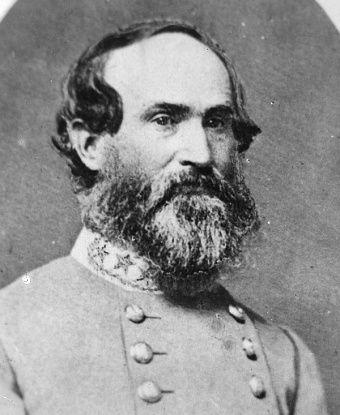
In the tactics of the era, fighting rarely persisted into the evening. It was just too difficult for commanders to maneuver troops in the dark. No one ever initiated a maneuver after dark. As far as Early was concerned, his men were settled for the day. Besides, he’d already shifted a portion of his division. Just before dusk, his scouts reported a Union force of unknown size were approaching from the east. In order to protect his left flank, he shifted one brigade to face east along the road from Hanover. His scouts had been wrong there was no Union force approaching but his men were in place and he wasn’t intending to move them again.
He did, however, send scouts to scope out Culp’s Hill. They reported no Union activity there. They had apparently scaled the west face of the hill and missed the fact that the Iron Brigade was on the lower south face. This convinced Early that any action could await morning.
About midnight, Lee rode through the city and found Ewell’s HQ co-located with Early. MG Rodes was there as well, Johnson’s division had seemingly become entangled with Hill’s supply wagons near Cashtown and had had to back-track to make the turn to the east to join with his corps.
Ewell allowed Early to offer the reasons for his inaction with regards to Culp’ Hill. Early also reminded Lee that the last orders he had received dating back to 29 June were not to engage in any interaction with enemy forces until the Army of Northern Virginia was re-consolidated. With all that had transpired that day, Lee had almost forgotten about the ‘do not engage’ order that he had issued. He was hoping not to get any of his scattered forces bogged down in a fight where he’d have to come to rescue them. Instead 4 of his 9 divisions had been engaged.
Early’s run-in with Eleventh Corps that afternoon was just to sweep them aside. Early further explained how late in the day he had received the order that Lee had routed through Ewell. Lee could hardly fault either Early or Rodes for moving on after their clashes with the Union forces. Rodes has moved down passed Hill’s Corps and established his encampment quite strategically at the foot of the town cemetery. Early had simply gone where the enemy wasn’t. His camp was secure but tactically less well placed.
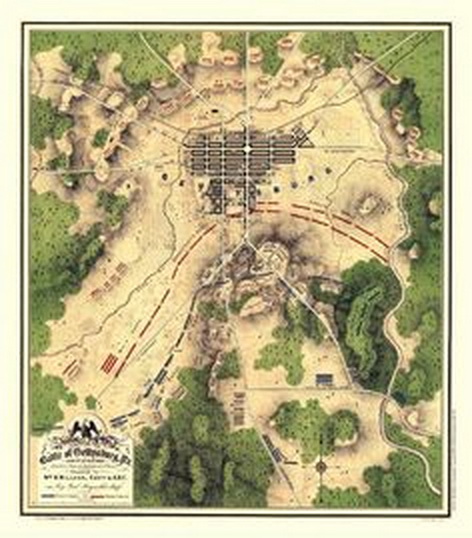
Lee was considering having Early move farther west to better position him, but Ewell argued that if he was allowed to bring in the soon-to-arrive division belonging to Johnson, then he could use his entire corps strength to attack both Culp’s Hill and the cemetery stronghold in the morning. They agreed that when Johnson arrived he’d be positioned to the south of Early facing the hill from the east.
Lee hadn’t yet completely formulated his Day 2 play, but he assigned Ewell a somewhat secondary role. He was to wait until he heard clear sounds of action in the south then launch his attacks. Lee knew that without Culp’s Hill it would be hard to breech the Union’s ‘castle walls’.
A second take:
Every war has (in)famous battles unique to that war. Many of the most hard-fought battles involved the attack or defense of a ‘hill’ = the high ground commanding an area. The failure of the Rebel forces to seize an unoccupied Culp’s Hill is often deemed as their most critical failure that all but ensured the success of the Union’s defense at Gettysburg. Therefore, Culp’s Hill can take its place among the most critical battles that never took place.
During the Civil War, no ‘hill’ is more iconic than the Union defense of the series of hills south of Gettysburg. But one of the most critical parts of that engagement was a battle that was never actually fought. How is it possible that a battle that was never fought could have changed history? It’s because of the critical position of this hill and the series of battles that took place on the two subsequent days.
1 JUL 1863, while BG Buford’s cavalry and MG Reynold’s First Union Corps were engaged in heavy fighting to the west of the city of Gettysburg, units from both armies that were arriving late in the afternoon were converging to the south of the city. Lead elements of the Union 11th Corps had occupied a hill just south of Hanover Rd. Lead elements of Confederate MG Early’s division met and engaged them in what was hardly more than a skirmish. Heavily outnumbered, the Union force quickly withdrew. They sought higher ground and found themselves on Culp’s Hill. This was eventually to become the extreme right flank of the Union defensive line; the tip of the fish-hook-shaped line.
Of course, being of the far east side of the city all of this was taking place out of sight of GEN Lee and even MG Early’s Corps commander, LTG Ewell, had yet to arrive at the battlefield. Early’s orders when he had departed the York area earlier that morning were to converge with Lee’s main force at Gettysburg but to avoid a major engagement. Lee, himself, had only rudimentary maps of the area and it wasn’t until late in the afternoon when he was able to make his way to the Lutheran Seminary that he got his first look at the line of hills east of Seminary Ridge that were to become the Union defensive position. He had dispatched a message to Ewell for him to attack Culp’s Hill “if practicable”. This order was passed down to Early. Since darkness was falling, Early sent out a scouting party, but they never got to the eastside of Culps Hill. It was occupied by Union troops of the 1st Corps, mainly the Iron Brigade from Michigan, who had withdrawn from the southern end of the first day’s battle directly to the cemetery to begin preparing a defensive position.
Historians seem to agree to disagree over what ‘could have been’ at this point. In retrospect, it is clear that if the Rebel’s had been able to secure Culp’s Hill, the outcome of the engagement at Gettysburg may have been completely different. Could Meade have established a westward facing defensive line with a Confederate stronghold on his flank and essentially in his rear area? BG Buford had foreseen the inherent value of defending the string of hills south of Gettysburg, but except for the cemetery itself and a portion of the adjacent ridge occupied by the lead elements of MG Hancock’s 2nd Corps, a full defensive line had yet to form.
For his part, Early made the critical decision to do nothing that night of 1 July. His men had marched all day and although they had not yet engaged in any prolonged fighting, he saw that they needed a meal and a rest before pressing any attack. Seemingly, there were two other factors that influenced this decision. As night fell, Early’s division was the only one east of the city. He had no back-up. He had also reportedly received reports that there were Union troops approaching from the east on his left flank. He dispatched one of his three brigades to the area of Hanover Rd. to protect that flank.
Lee was initially dissatisfied by Early’s inaction, but when he was apprised of the entire picture as Early saw it, he had to agree with Early’s decisions. The number of Union troops and artillery in and around the cemetery removed any “advantage” that Early’s troops might have expected. In point of fact, an attack on Cemetery Hill late in the afternoon of 2 July by Ewell’s division commanded by MG Rodes was thrown back with heavy losses on the rebel side. https://www.youtube.com/watch?v=3EXhdZ8bnpA
During the night 0f 1-2 July, Ewell’s third division, under MG Johnson finally arrived at Gettysburg and was positioned south and east of Early’s position facing Culp’s Hill from the east. On the afternoon of 2 July, in a supporting attack while Longstreet was attacking the Union southern (left) flank, Johnson’s four brigades attacked Culp’s Hill and managed to dislodge the Union troops from the trenches on the lower slopes but there the attack bogged down. Another attempt was made on the early morning of 3 July – prior to Pickett’s ill-fated ‘charge’ — but that too failed to dislodge the Union troops and their ability to rapidly dispatch reinforcements thwarted any lasting success on the part of the rebel forces. https://www.youtube.com/watch?v=I9298GhRwcY
Military tactics of the day was for fighting to cease at dark. It was hard enough to control the movement of units in the light of day. Night attacks were almost unheard of. The WHATIF of 1 July 1863 was: could Early have possibly occupied Culp’s Hill without a major fight? Could he have advanced in the waning light? After-action reports state that on the morning of 2 July Johnson dispatched a scouting party onto Culp’s Hill. That group was ambushed by elements of the 11th Corps which had continued to arrive during the night to occupy that terrain. By the time Johnson attacked late in the afternoon – as a follow-on to Longstreet’s much delayed attack in the south – the Union troops had erected a formidable defense of trenches and bulwarks on the slopes of Culp’s Hill and adjacent areas. A small hill just to the south of Culp’s allowed the Union a very advantageous position to lend support to the Union defenders on Culp’s Hill.
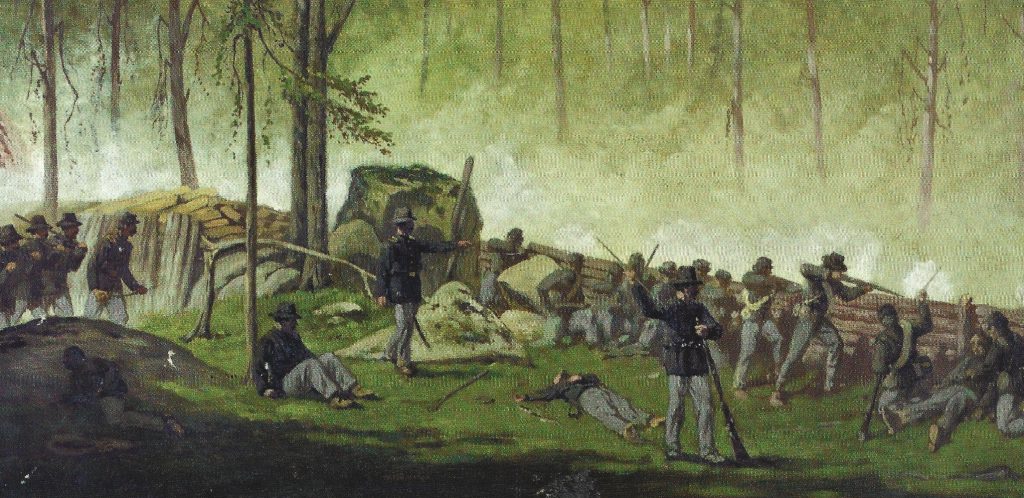
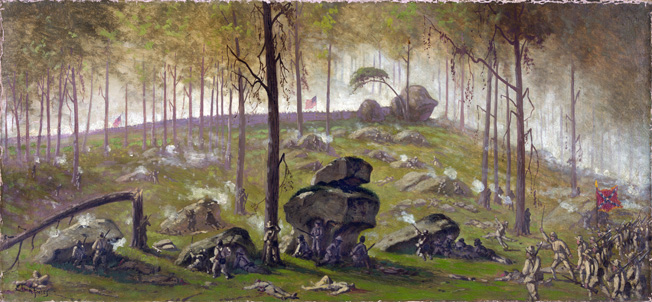
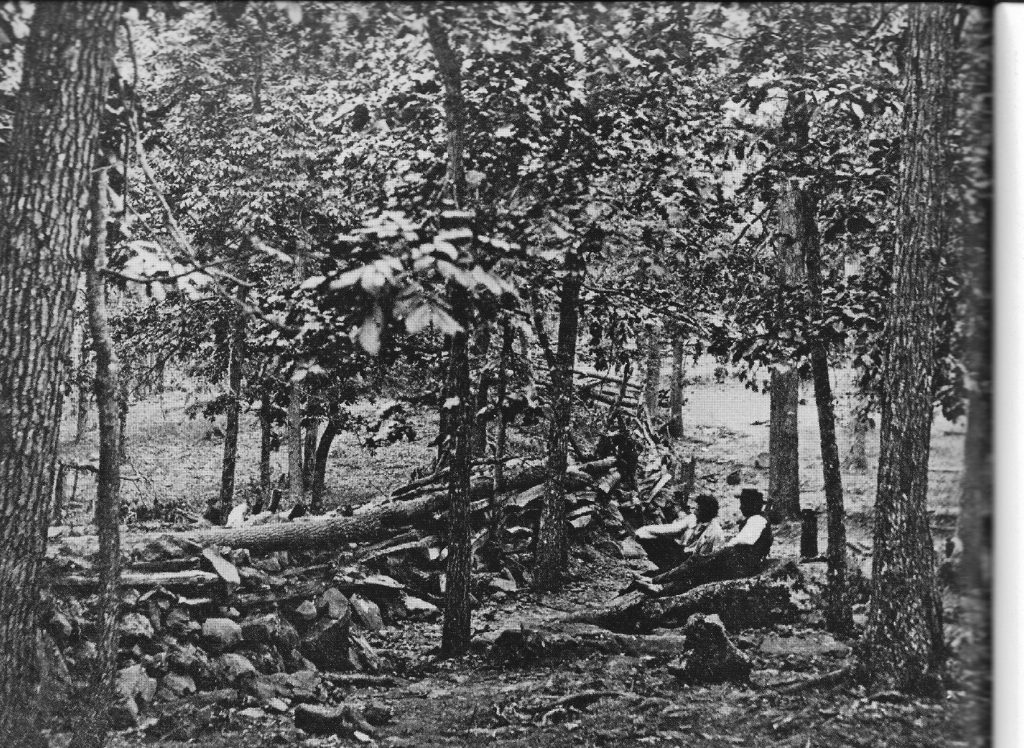
Two paintings above depict the famous ‘rock’ that was the focus of much fighting on day 2 and 3. One views it from the Union side; the other from the east Rebel view. The B&W is a photo of BG Green’s rampart that held off repeated Rebel attacks.
Some questions about the timing of events but a good visual:
A interesting perspective and analysis:
